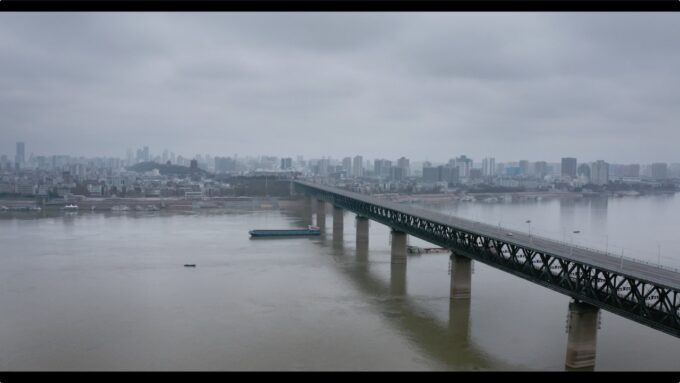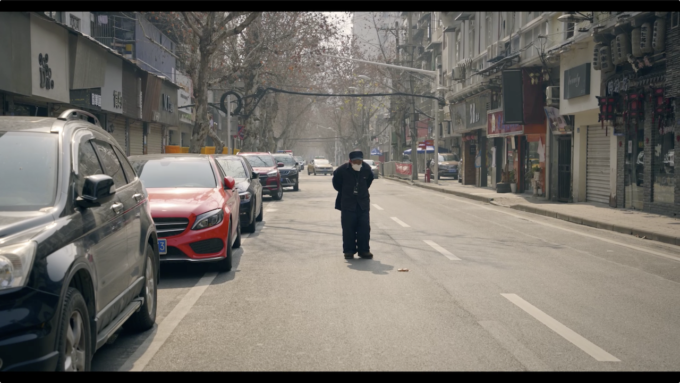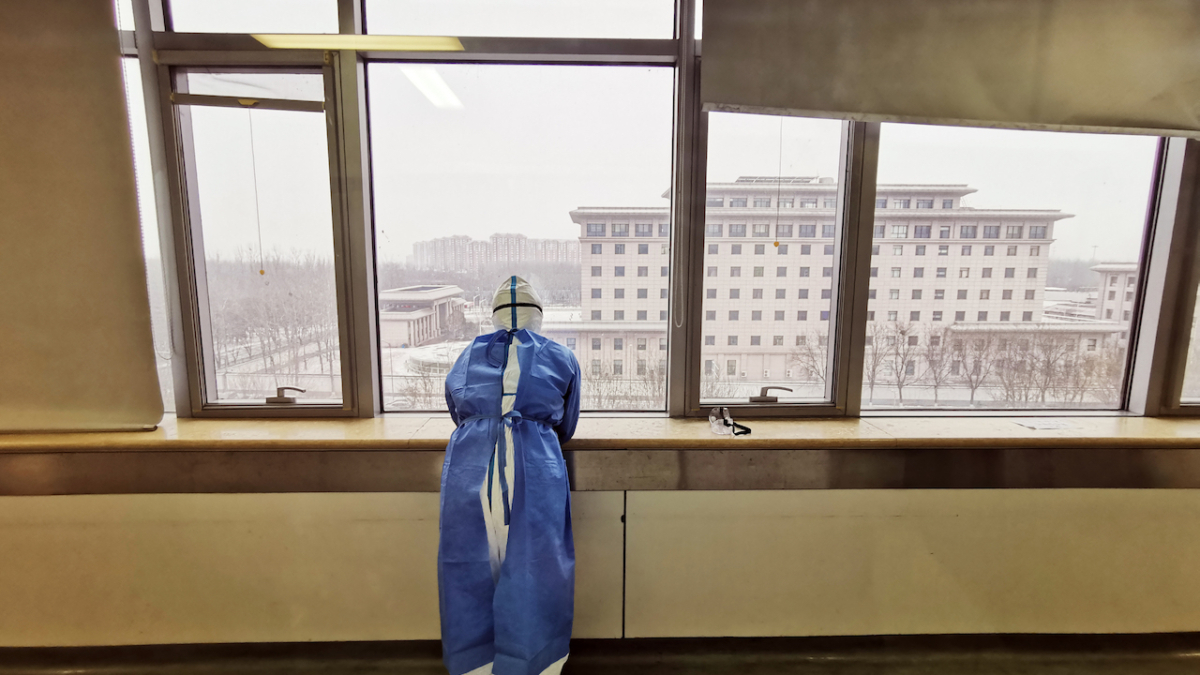Yung Chang humanizes a city in a pandemic
Written By: Demi Guo
This article may contain spoilers.
There is no shortage of use of the word “Wuhan” now. Most people in the world have learned about it through headlines that signaled the pandemic.
“Wuhan Wuhan” is a documentary shot behind the walls of Wuhan’s lockdown, when the COVID-19 virus began its first wave in 2020. It follows four sets of “characters” — Yin, a factory worker now volunteering as a driver, and his pregnant wife Xu; Xiuli and her young son Lailai, who both just want out of the quarantine zone; Psychologist Zhang, who is spirited even as she weaves through the quarantine zone; Nurse Susu and Emergency Room Chief Zheng, who tend to the patients barely clinging on.
And a surprise character! Grandpa Shen! The curmudgeonly old man Susu and Zheng care for in the emergency room will be holding our hand through this story. This documentary doesn’t just put one face to the name of the pandemic center, but several.
This story was never meant to be a political film, but rather, cut through the political “war of words” that stood between humanizing Asians, Chinese and the people of Wuhan. “It really was about just showing a slice of an experience through Chinese eyes, of the Wuhan city,” Director Yung Chang said.
One of the film’s shots includes a small shrine dedicated to Li Wenliang, the doctor who blew the whistle on the virus before the outbreak, only to be suppressed and reprimanded by the Chinese government. He passed away in February due to COVID-19, right as the outbreak officially began. The pedigreed journalist Theresa Fallon, founder of the Centre for Russia Europe Asia Studies, turned his name and “Wuhan” into acronyms for preventing the spread of COVID-19. When both Chinese and Chinese American users protested, she justified her racism by saying, “Calling out racism is Beijing’s strategy.”
(Her tweets have since been deleted, but the thread remains here.)
“Wuhan Wuhan” was shot and edited during the first months of the pandemic. In that time, the conflation of the Chinese government with the Chinese people, and by extension Asians all around the world, rippled into the rise in anti-Asian violence we see now. Chang, himself a Canadian of Beijing and Shanghai descent, was harassed the week before he signed onto the film. “They don’t understand what’s happening in Wuhan,” Chang said. “There are innocent people in Wuhan who are dealing with this pandemic.”
(Chang wrote a detailed account of his anti-Asian encounter in an article for CBC here.)
Chang recalls sharing the film with westerners once it premiered; they reacted with surprise that the city isn’t a “… backwards village with a wet market,” he said. The opening shots of the film show scenes that scream “Wuhan” to the familiar eye — hazy gray skies, long bridges and new skyscrapers over lakes. Lakes, especially, as far as the eye can see.

“What I know it for is the music scene*,” Chang said. “It’s a place of intellectuals, where forward-thinking people congregate and create things. And to me, it’s a creative hub.”
Hua Lun, the artist group that produced the “Wuhan Wuhan” soundtrack, had already caught Chang by the ear when he watched a film called “An Elephant Sitting Still.” When he found out that the group is from the city itself, he signed them on for his documentary. “So much of the film was about representing what Wuhan is beyond this negative label. The calligraphy in the opening of the film is made by a Wuhanese calligrapher, and some of my editing team is from Wuhan.”
The goal was to break the confines of a headline. “Documentaries are not news stories,” Chang said. “Documentaries are meant to touch emotionally and provoke thinking, because you’ve dedicated yourself for a 90-minute journey through another world. And that requires time and thinking and openness.”
Yung Chang is known for his cinéma vérité style — meaning, the camera and filmmaker are a fly on the wall, observing mundane but intimate scenes in the subjects’ everyday lives. The editor builds the story out of the footage after. He uses the style in his past works, like “Up the Yangtze” and “China Heavyweight.”
He is usually on the field, but this time, it was his team at Starlight Media who took down hours of footage in Wuhan and sent it to him in locked-down Toronto. His starting point was the editor’s seat.
Luckily for him, the footage linked closely to his process. “What that means is that there’s a very active camera. There’s a very inquiring camera,” Chang said. “Someone is asking questions and provoking the subjects to think deeper and speak about their feelings a little more.”

His team also shot with what he calls a “cinematic lens,” meaning the subjects don’t always have to talk. “Sometimes the most powerful images are images of people alone, or how you frame somebody, and in context with the scene that comes before and after. Knowing the footage was shot in a beautiful way that followed my technique was very reassuring.”
Assembling the film was a breeze compared to before — he was not as emotionally attached to the footage as he would have been if he were there to shoot it with his own hands. “I could love a scene because … I thought at the time that it would be perfect, but then I had no distance to allow a reinterpretation of that footage,” Chang said. “Oftentimes, I find what you hold onto is not what is gonna make a film as a whole better.”
The film originally opened on a quote that was popular on Chinese social media at the time. It was cut, but Chang recites it at every interview about “Wuhan Wuhan.” It was written in the seventh century by a Japanese official in a letter to a Chinese official:
“We are from different lands and are separated by mountains and waters.
Yet above us, we share the same sky and the same feelings.”
— Nagaya no Kimi
The team cut it when they rewatched it this year, right before it was released. “‘This feels different now,’” Chang remembered thinking. “We don’t need the preamble. We all get it.”
“Wuhan Wuhan” isn’t the only piece of media that people have been releasing about the city.
- *Goldthread, a digital culture platform under the South China Morning Post, covered “Wuhan calling: How the city’s punk rock scene changed China’s youth.”
- Goldthread also covered “The Noodle Dish that Built Wuhan” — which can be found in New York’s own Flushing, Queens.
- The author of this article, who has also contributed writing for Goldthread, wrote a brief memoir of her memories in Wuhan for BESE: “The Wuhan I Knew: The Pre-COVID-19 City Of My Youth.”
- Laura Gao, a Chinese American from Wuhan, is releasing a graphic novel about her experience with her hometown becoming a household name in “Messy Roots.”
- Min Tu, a Chinese American with roots in Wuhan, released a short comic called “Hello Home (Hello Wuhan).”
“Wuhan Wuhan” makes its New York City premiere at the 44th Asian American International Film Festival. Ticket and screening information can be found here.

